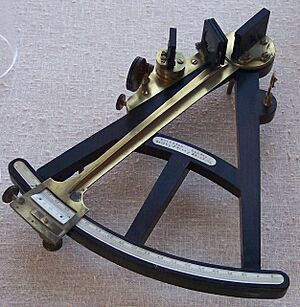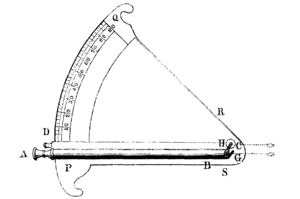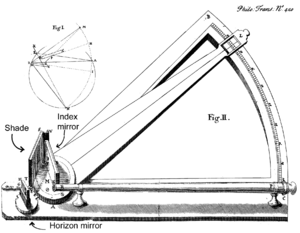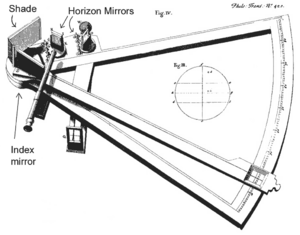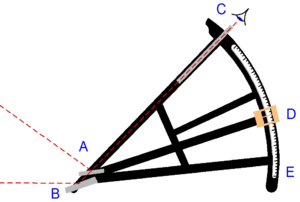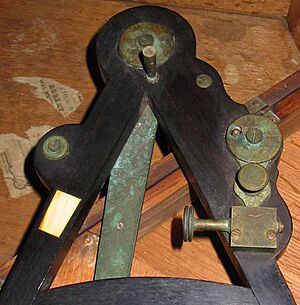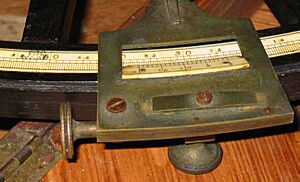Octant (instrument) facts for kids
The octant is a special tool used in navigation to help sailors find their way. It's also called a reflecting quadrant. It uses mirrors to measure angles, like the height of the Sun or a star above the horizon. This helps sailors figure out their ship's position at sea.
Contents
What's in a Name?
The name octant comes from the Latin word octans. This means "eighth part of a circle". This is because the instrument's main curved part, called the arc, is one-eighth of a full circle.
It's called a reflecting quadrant because it uses mirrors to bounce light. These mirrors make the angle you measure seem twice as big. So, even though the arc is only one-eighth of a circle, you can measure up to a quarter of a circle, which is 90 degrees. A quarter of a circle is also called a quadrant.
Who Invented the Octant?
Newton's Idea
The famous scientist Isaac Newton actually thought of a reflecting quadrant around 1699. He wrote down how it worked and gave the details to his friend, Edmond Halley. But for some reason, Halley didn't publish Newton's description until 1742, after Halley had passed away. Because of this delay, Newton didn't get the credit for the invention right away.
Newton's tool used two mirrors, but they were set up a bit differently from how they are in modern octants. His instrument had a 45-degree arc, which allowed it to measure angles up to 90 degrees. It also had a very long telescope, about three to four feet long! This long telescope helped make the measurements more accurate.
The Main Inventors
Two different people independently invented the octant around 1730. They were John Hadley (1682–1744), a mathematician from England, and Thomas Godfrey (1704–1749), a glassmaker from Philadelphia. Both of them deserve credit for inventing it. However, Hadley often gets more recognition. This is partly because London and the Royal Society (a famous science group) were very important in the world of scientific tools back then.
Other people also created similar instruments around this time. Caleb Smith, an English insurance broker, made one in 1734. Jean-Paul Fouchy, a French math professor, made one in 1732.
Hadley's Designs
John Hadley made two different versions of the reflecting quadrant. The second version is the one that looks like the octant we know today.
Hadley's First Design
Hadley's first reflecting quadrant was quite simple. It had a frame with a 45-degree arc. It used a small sighting telescope. There was a large index mirror on a moving arm and a smaller horizon mirror on the frame. The horizon mirror let the observer see two things at once: a distant object directly and another object reflected in the mirrors. By moving the arm, a sailor could measure the angle between two objects.
Not many of these first designs were ever made.
Hadley's Octant
Hadley's second design is the one that became very popular. It had an index mirror on the moving arm, just like before. But this time, it had two horizon mirrors. One mirror was small enough so the telescope could see straight ahead and also see the reflected view. This setup allowed sailors to see an object directly and another object reflected in the mirrors at the same time. This made it easy to measure angles up to 90 degrees.
A big improvement in this design was that the instrument could be held vertically. This made it easier to use and gave more space for the mirrors. Hadley even thought of a way to use the second horizon mirror to measure angles from 90 to 180 degrees. This would have made the octant even more useful, but this special feature wasn't usually included in octants that were sold.
Smith's Astroscope
Caleb Smith, the English insurance broker, created his own octant in 1734. He called it an Astroscope or Sea-Quadrant. His design used a fixed prism along with an index mirror. Prisms were sometimes better than mirrors back then because it was hard to make good mirrors.
However, Smith's Astroscope had some problems. For example, the way you had to look down through the instrument made it harder to use than Hadley's design. Because of these issues, Smith's instrument wasn't used very much.
Why the Octant Was Great
The octant was a big step forward for navigation tools. Here are some reasons why:
- Easy to Use: When a ship moved up and down on the waves, the horizon and the stars seemed to move together in the octant. This made it much easier for sailors to line up their measurements. It also meant that different sailors would get more similar results.
- Accurate and Smaller: Octants could measure angles very precisely, even though they were smaller than older tools. An octant could be half the size of a Davis quadrant but still be just as accurate.
- Day and Night Use: The octant had special shades that could be moved over the mirrors. This allowed sailors to look directly at the bright Sun without hurting their eyes. When observing faint stars at night, the shades could be moved out of the way.
By the late 1700s, the octant and the sextant (a similar but larger instrument) had almost completely replaced all the older navigation tools.
How Octants Were Made
Early octants were mostly made of wood. Later ones started using ivory and brass parts. The first mirrors were made of polished metal because it was hard to make good glass mirrors back then. As glass polishing got better, glass mirrors became more common. These early glass mirrors used a coating of mercury and tin. Silver or aluminum coatings weren't available until the 1800s. Because the early metal mirrors weren't perfect, most early octants used a simple sighting pinnula (a small hole to look through) instead of a telescope.
Older octants sometimes had special markings called transversals on their scales. But then, a new type of scale called a vernier was invented. Verniers made it much easier to read the scale very accurately, down to one minute of arc. This made octants more popular, and verniers became standard on most octants.
Many octants were produced. They were often made of wood and ivory, which made them cheaper than all-brass sextants. This made them popular for many ships. The design became very standard, with many makers using the same style. Different workshops would even specialize in making different parts, like wooden frames or brass pieces. For example, a company called Spencer, Browning and Rust made very accurate ivory scales that were used by many other octant makers. You can often find their initials, "SBR," on octants made by other companies.
If you look at the octant picture at the top of this article and the detail pictures, you'll see they look very similar. But they were made by different companies! The one at the top is from "Crichton - London," while the detailed pictures are from "Spencer, Browning & Co. London."
Octants came with different options. The cheapest ones had markings directly on the wood frame and used a simple sighting pinnula. Adding ivory scales, a brass index arm, or a vernier would make the price go up.
The Octant's Decline
In 1767, a new book called The Nautical Almanac was published. It contained tables that helped sailors use a method called lunar distances. This method allowed them to find the exact time by measuring the angle between the Sun and the Moon. Sometimes, this angle was larger than 90 degrees, which an octant couldn't measure. Because of this, a larger instrument was needed, and that's how the sextant was developed.
From then on, the sextant became the main tool for naval navigators. It continued to be improved and was more accurate. However, octants were still made well into the 1800s. They were generally less accurate and cheaper than sextants. This made them a good choice for merchant ships and fishing boats.
Many navigators would use both a sextant and an octant. They would use the very accurate sextant carefully for lunar distance measurements. But for everyday measurements of the Sun's height, they would use the more affordable octant. This helped protect the expensive sextant while still getting good measurements.
Bubble Octant
From the 1930s to the 1950s, special bubble octant instruments were made for airplanes. These octants had an "artificial horizon" in the form of a bubble. This bubble helped pilots and navigators find the horizon when they were flying high above the Earth. Some even had features to record the measurements.
How to Use an Octant
Using and adjusting an octant is very similar to using a navigator's sextant.
Other Reflecting Tools
Hadley wasn't the first to think of a reflecting quadrant. Robert Hooke invented one in 1684. Other octants were also developed by Jean-Paul Fouchy and Caleb Smith in the early 1730s. However, these didn't become as important in the history of navigation as Hadley's octant.
Images for kids
See also
- List of astronomical instruments
- Octant (plane geometry)


